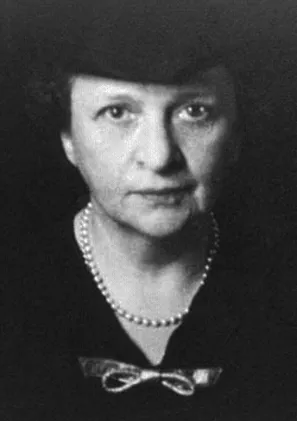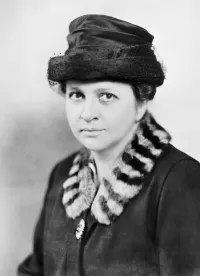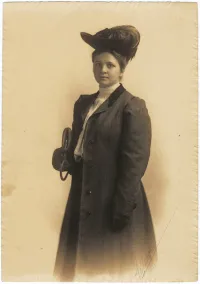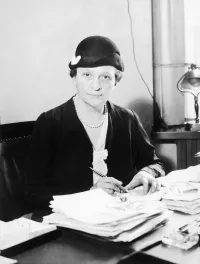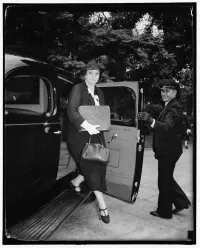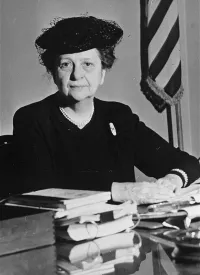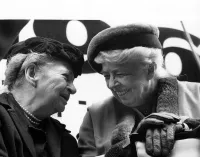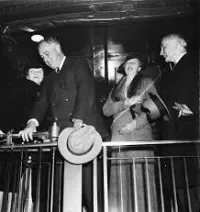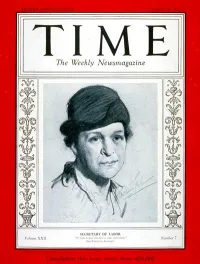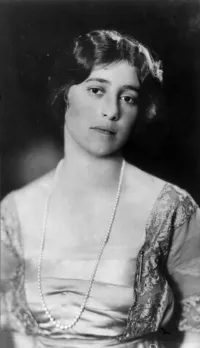Biography
1880 - 1965
"The door might not be opened to a woman again for a long, long time, and I had a kind of duty to other women to walk in and sit down on the chair that was offered, and so establish the right of others long hence and far distant in geography to sit in the high seats."
- Frances Perkins
Frances Perkins – who was raised to "live for God and to accomplish something in life" – embraced the cause of Women’s Suffrage and the challenges facing working people. While teaching at Lake Forest Academy near Chicago, IL, her passion for social justice led to volunteer work at Hull House in one of the city’s poorest neighborhoods. After earning degrees in Economics, Sociology, and Political Science, she became the head of the National Consumers League, then New York’s State Commissioner of Labor. In 1933 newly-elected President Franklin Delano Roosevelt (FDR) tapped Perkins to be U.S. Secretary of Labor – the first woman to hold a Cabinet position. As America slowly recovered from the economic collapse triggered by the stock-market crash of 1929, Perkins became the architect of FDR’s “New Deal” – a collection of far-reaching public policy initiatives which empowered the federal government to meet the needs of its citizens struggling to survive the Great Depression. She is credited with passage of the Social Security Act and the Fair Labor Standards Act which established unemployment benefits, pensions, welfare, workplace safety regulations, child labor laws, the first minimum wage, overtime restrictions, and the standard forty-hour work week. Though her record of progressive accomplishments on behalf of working people while Secretary of Labor remains unrivaled even today, FDR began to distance himself from Perkins, a known pacifist, as the specter of World War II grew. Despite her waning influence, she remained with his administration for an unprecedented twelve years until his death in 1945, and then served on the United States Civil Service Commission under his successor, Harry S. Truman, until 1952. Perkins was romantically involved with railroad heiress Mary Harriman Rumsey, who chaired FDR’s Consumer Advisory Board. Because of the closeted nature of their relationship, Perkins was forced to grieve in silence over Rumsey’s untimely death in 1934, even while she lost the home they had shared. Largely forgotten, though still scorned in some quarters for the liberal policies she championed, Frances Perkins transformed Americans’ expectations of their government. There is not a single U.S. citizen whose life has not been touched by her efforts in some way. She died on May 14, 1965 at the age of 85.
1880 - 1965
"The door might not be opened to a woman again for a long, long time, and I had a kind of duty to other women to walk in and sit down on the chair that was offered, and so establish the right of others long hence and far distant in geography to sit in the high seats."
- Frances Perkins
Frances Perkins – who was raised to "live for God and to accomplish something in life" – embraced the cause of Women’s Suffrage and the challenges facing working people. While teaching at Lake Forest Academy near Chicago, IL, her passion for social justice led to volunteer work at Hull House in one of the city’s poorest neighborhoods. After earning degrees in Economics, Sociology, and Political Science, she became the head of the National Consumers League, then New York’s State Commissioner of Labor. In 1933 newly-elected President Franklin Delano Roosevelt (FDR) tapped Perkins to be U.S. Secretary of Labor – the first woman to hold a Cabinet position. As America slowly recovered from the economic collapse triggered by the stock-market crash of 1929, Perkins became the architect of FDR’s “New Deal” – a collection of far-reaching public policy initiatives which empowered the federal government to meet the needs of its citizens struggling to survive the Great Depression. She is credited with passage of the Social Security Act and the Fair Labor Standards Act which established unemployment benefits, pensions, welfare, workplace safety regulations, child labor laws, the first minimum wage, overtime restrictions, and the standard forty-hour work week. Though her record of progressive accomplishments on behalf of working people while Secretary of Labor remains unrivaled even today, FDR began to distance himself from Perkins, a known pacifist, as the specter of World War II grew. Despite her waning influence, she remained with his administration for an unprecedented twelve years until his death in 1945, and then served on the United States Civil Service Commission under his successor, Harry S. Truman, until 1952. Perkins was romantically involved with railroad heiress Mary Harriman Rumsey, who chaired FDR’s Consumer Advisory Board. Because of the closeted nature of their relationship, Perkins was forced to grieve in silence over Rumsey’s untimely death in 1934, even while she lost the home they had shared. Largely forgotten, though still scorned in some quarters for the liberal policies she championed, Frances Perkins transformed Americans’ expectations of their government. There is not a single U.S. citizen whose life has not been touched by her efforts in some way. She died on May 14, 1965 at the age of 85.
Lesson Plan
Please login or register for an account to view this lesson plan.
Demography
Demography
Gender Female
Sexual Orientation Lesbian
Gender Identity Cisgender
Ethnicity Caucasian/White
Faith Construct Protestant
Nations Affiliated United States
Era/Epoch First-wave Feminism (1848-1930) Great Depression (1929-1939) Roaring Twenties (1920-1929) World War II (1939-1945)
Field(s) of Contribution
Academics
Advocacy & Activism
Civics, Government, Politics, & Law
Education
Lecturer
Politics
Social Justice
US History
Commemorations & Honors
Washington D.C. and Maine Homes Designated National Historic Landmarks
Episcopal Church Liturgical Calendar Feast Day Honor on May 13
First Woman Cabinet Member in the United States (1933-1945)
Featured on the Cover of Time Magazine (1933)
Telluride House and Cornell University's School of Industrial and Labor Relations Established the Frances Perkins Memorial Fellowship (1967)
President Jimmy Carter Renamed US Department of Labor Headquarters the Frances Perkins Building (1980)
Posthumous National Women's Hall of Fame Inductee (1982)
Demography
Gender Female
Sexual Orientation Lesbian
Gender Identity Cisgender
Ethnicity Caucasian/White
Faith Construct Protestant
Nations Affiliated United States
Era/Epoch First-wave Feminism (1848-1930) Great Depression (1929-1939) Roaring Twenties (1920-1929) World War II (1939-1945)
Field(s) of Contribution
Academics
Advocacy & Activism
Civics, Government, Politics, & Law
Education
Lecturer
Politics
Social Justice
US History
Commemorations & Honors
Washington D.C. and Maine Homes Designated National Historic Landmarks
Episcopal Church Liturgical Calendar Feast Day Honor on May 13
First Woman Cabinet Member in the United States (1933-1945)
Featured on the Cover of Time Magazine (1933)
Telluride House and Cornell University's School of Industrial and Labor Relations Established the Frances Perkins Memorial Fellowship (1967)
President Jimmy Carter Renamed US Department of Labor Headquarters the Frances Perkins Building (1980)
Posthumous National Women's Hall of Fame Inductee (1982)
Resources
Resources
Downy, Kristen. The Woman Behind the New Deal: The Life and Legacy of Frances Perkins. New York: Anchor Books, 2009.
http://bestpossiblelife.wordpress.com/2009/02/25/praise-for-new-biography-of-frances-perkins/
http://bandofthebes.typepad.com/bandofthebes/2012/04/born-april-10-frances-perkins.html
http://www.thelizlibrary.org/undelete/WHM/WHM12.html
http://worldofwonder.net/bornthisday-liberal-pioneer-frances-perkins/
Resources
Downy, Kristen. The Woman Behind the New Deal: The Life and Legacy of Frances Perkins. New York: Anchor Books, 2009.
http://bestpossiblelife.wordpress.com/2009/02/25/praise-for-new-biography-of-frances-perkins/
http://bandofthebes.typepad.com/bandofthebes/2012/04/born-april-10-frances-perkins.html
http://www.thelizlibrary.org/undelete/WHM/WHM12.html
http://worldofwonder.net/bornthisday-liberal-pioneer-frances-perkins/
